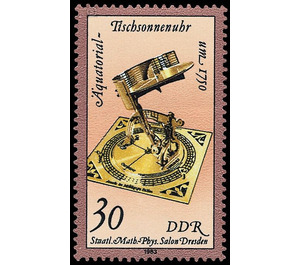Precious sand and sundials - Germany / German Democratic Republic 1983 - 30 Pfennig
Theme: Devices, Items & Instruments
| Country | Germany / German Democratic Republic |
| Issue Date | 1983 |
| Face Value | 30.00 |
| Color | brown |
| Perforation | K 14 |
| Printing Type | Rotogravure 2 |
| Stamp Type | Postage stamp |
| Item Type | Stamp |
| Chronological Issue Number | 2541 |
| Chronological Chapter | GER-DDR |
| SID | 849588 |
| In 17 Wishlists | |
Precious sand and sundials The Department of Postal and Telecommunications of the German Democratic Republic publishes six multicolored special postage stamps with images of sand and sundials from the State Mathematical-Physical Salon Dresden. Special cancellations from June 7 to August 6, 1983 Precious sand and sundials In the collection of watches of the State Mathematical-Physical Salon in the Dresden Zwinger, the sun and sand clocks from four centuries occupy a significant, much-acclaimed place. The history of the sundial, the oldest human timekeeping instrument, goes back well over 4,000 years, to ancient times in Egypt, China and Mesopotamia. In ancient times, sundials of various designs, including small portable instruments, were widely used, especially by Greeks and Romans. The "modern" sundial with earth-axes parallel polos, which indicates the same (equinoctial) hours, is an invention of the Arabs. It experienced its heyday in the 16th and 17th centuries. Variety, richness of forms, noble material and decorative design of sundials in master craftsmanship show the great interest that has been placed in these timepieces as objects of utility as well as representation in past centuries, especially in the Renaissance and Baroque periods. 30 Pfennig Value: Equatorial table sundial, around 1750 Material: Brass; Height about 17 cm This widespread type of equatorial sundial - whose designation is based on the dial position - was made according to a design from J. F. Penthers book "Gnomonica fundamentalis et mechanica", Augsburg 1733. The shadow of the gold triangle indicates the hours on the round dial and the corresponding zodiac sign or date on the inner surface of the cylinder barrel.


